Seagrape: Plant Care and Growing Guide (With Pictures)- Identification Guide
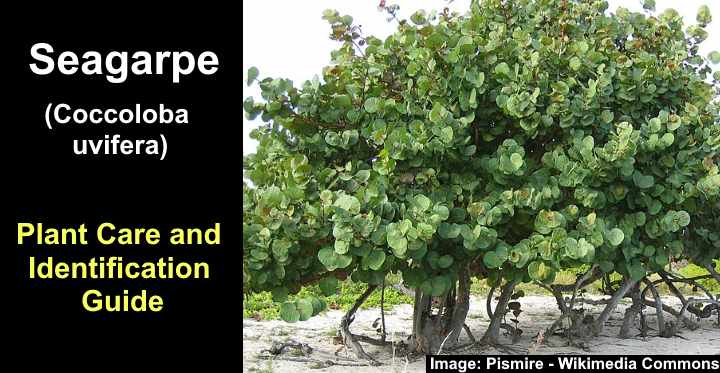
Seagrape (or sea grape) plants are beautiful tropical trees or shrubs known for their glossy green leaves and clusters of small round fruits. In tropical climates like Southern Florida, seagrapes are popular ornamental shrubs or trees thanks to their attractive foliage and grape-like fruits. The plants thrive in coastal areas, adding color, texture, and beauty to garden landscapes.
What is it about seagrape that makes it special in South Florida landscapes? This article is a complete plant care and growing guide for seagrape trees and shrubs. Pictures and descriptions of the plant’s features will help you better appreciate the eye-catching plant.
What is Seagrape Plant (Coccoloba uvifera)?

The seagrape (Coccoloba uvifera) is a tropical evergreen tree or shrub with grape-like fruits
Seagrape is an ornamental multi-stemmed tree native to central and southern Florida. It’s a member of the buckwheat family Polygonaceae and the genus Coccoloba. The shrub-like tree produces tasty fruits and has attractive green leaves with red stems. It’s tolerant of salt spray, wind, and shade and thrives in sandy soils.
Seagrape Identification (Coccoloba uvifera)
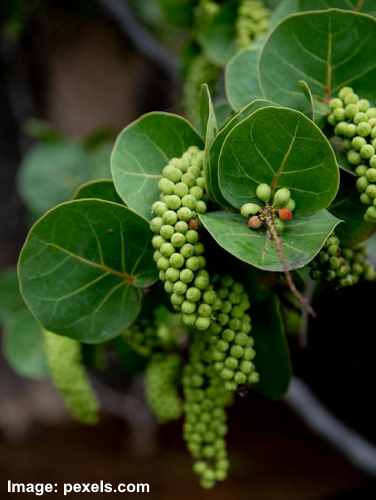
Immature seagrape fruit is green and turns purple-reddish when mature
Seagrape is identified by its large, round, leathery, evergreen leaves with prominent red veins and petioles. The leaves can measure up to 12” (30 cm) in diameter. It has clusters of creamy-white flowers that develop into round reddish-purple grape-like fruits that ripen in early fall.
Are Sea Grapes Edible?
Sea grapes are tasty fruits with a sweet and sour flavor. They have a taste and texture like ripe grapes or plums. Their juicy flesh is surrounded by thin, edible skin. The delicious round grape-like fruits are popular in Florida for making jellies or jams, or you can eat them straight off the tree.
Is Sea Grape an Evergreen Tree?
The seagrape tree is considered evergreen. It retains its leaves throughout the year, providing constant foliage. In colder environments, seagrape trees can lose their leaves and may not withstand frost or extended cold spells. They are not suited for cold climates and might need to be protected during colder months, or if grown in containers, you can overwinter them indoors in cooler climates.
Seagrape Plant in Florida
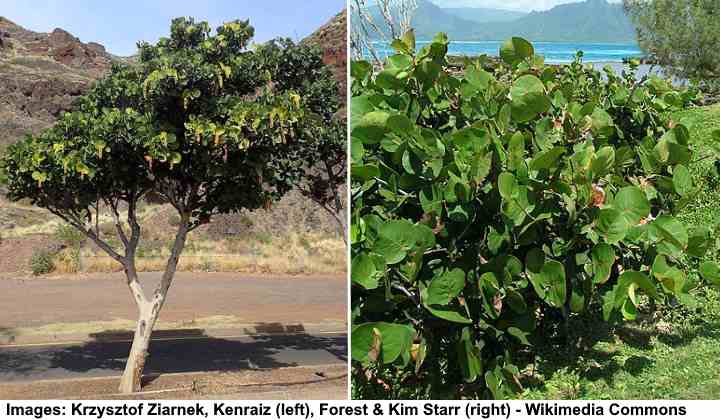
Seagrape plants can be grown as trees (left) or shrubs (right) and are common in South Florida gardens
Seagrape trees are popular ornamental plants in South Florida yards. The attractive multi-stemmed trees have a twisting trunk, making them picturesque accent plants. They are also popular in coastal landscapes because they tolerate salt air and help stabilize beach edges. The dense tree’s foliage also provides shade in beach landscapes.
Seagrapes growing on sand dunes are protected under Florida law. Therefore, you cannot destroy the tree or consume its fruits without special permission. So, if you want to enjoy the beauty and tasty fruits of seagrape plants, you must plant one in your garden, away from the waterfront.
Seagrape Plant: Description and Characteristics
Seagrape trees and shrubs are easy to identify along Florida’s coastlines. Apart from palm trees in Florida, they are one of the few species of trees that thrive in beach environments. Their large round leaves, clusters of inconspicuous flowers, and bunches of round reddish-purple fruits make them easy to spot.
Sea Grape Leaves
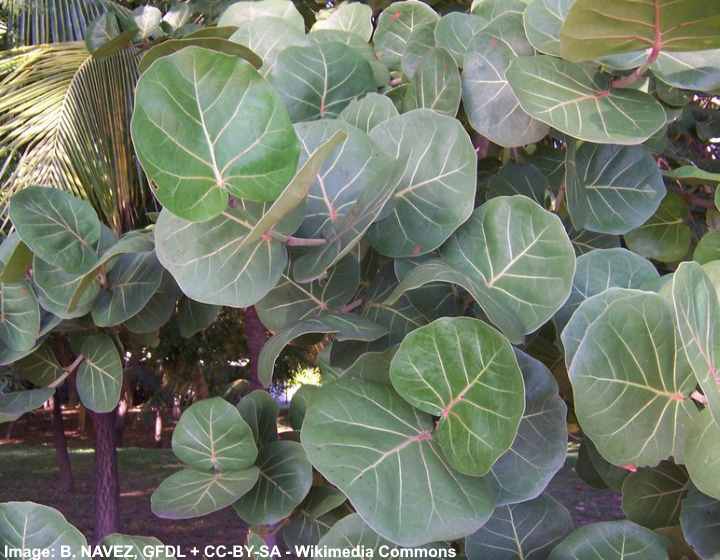
Sea grape leaves
Seagrape’s impressive leaves range in size from 8” to 12” (20 – 30 cm) long. The large, round, leathery leaves have a shiny green appearance, featuring red mid veins. In fall, the leaves turn bright crimson-red before dropping in colder climates. New leaves emerge a beautiful bronze hue, contrasting nicely with the glossy dark green leaves.

Sea grape leaves in autumn
Sea Grape Flowers
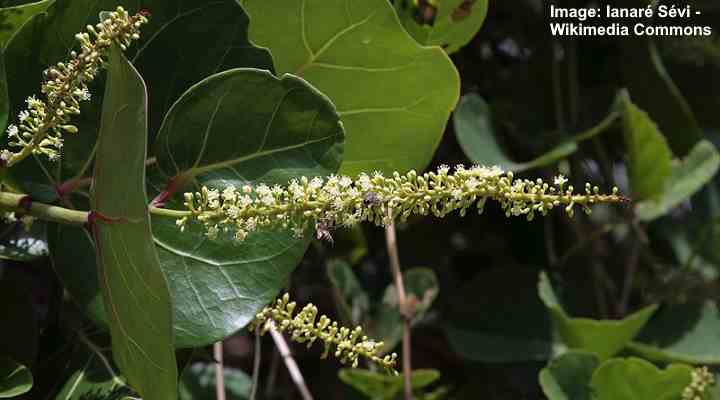
Sea grape flower stalk
Seagrape blooms with flowering stalks of small creamy-white flowers in dense clusters. Each raceme (cylindrical flower cluster) measures up to 12” (30 cm) long. Typically blooming from spring through summer, sea grape trees can bloom continuously in Florida throughout the year. After flowering, immature green fruits appear in mid-summer.
Sea Grape Fruit
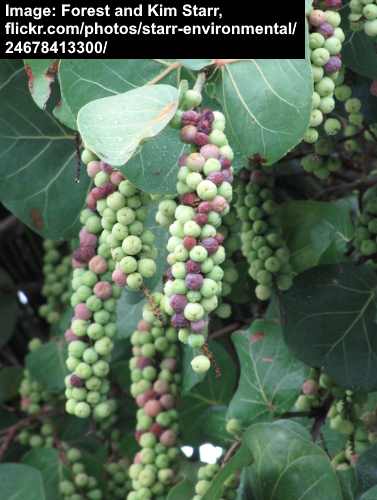
Sea grape fruit
The small fruits emerge green in early to mid-summer and ripen to red or purple by early fall. Unlike bunches of grapes, the round fruits grow on straight stalks, with each fruit measuring 0.75” (2 cm) in diameter. Besides being tasty for humans, the juicy reddish-purple grapes attract birds in fall.
Sea Grape Growth Habit
Sea grape trees are multi-stemmed plants with an open vase-shaped habit. They have a moderate growth rate and typically mature at 20 to 25 ft. (6 – 7.6 m) tall. However, pruning seagrape plants is easy, and you can train them to grow as an ornamental shrub 6 to 8 ft. (1.8 – 2.4 m) tall and wide.
Seagrape trees are suited for growing in USDA zones 9 to 11 in full sun or partial shade. Their year-long growth and evergreen foliage make them important ornamental plants in hot and humid climates.
Their robust root system allows them to help stabilize sandy beach areas. And, if they break in a hurricane, their resilient growth means they quickly resprout.
Sea Grape Salt Spray Tolerance
Seagrape trees have an exceptionally high tolerance for salt spray and salty soils. Therefore, the small ornamental trees are ideal for growing on beach edges or sand dunes. In addition to their salty air tolerance, established plants tolerate drought, partial shade, high winds, and dry soils.
Habitat and Distribution
Seagrape thrives in tropical and subtropical coastal habitats, primarily along shorelines, sandy beaches, and dunes. Native to tropical America, the beautiful trees thrive in the Caribbean and southern and central Florida. Its adaptability to various soil types, tolerance to salt, and high wind resistance allow seagrape to flourish in challenging coastal environments.
How to Care for Seagrape Trees
Seagrape trees are hardy trees for Florida’s landscapes. They perform best in well-drained, sandy soils and require continual watering until they are established. Also, regular pruning is necessary two or three times annually for the first ten years. This helps establish a strong trunk system. Once established, seagrape trees require little maintenance.
Watering requirements for seagrape trees
Seagrape trees require regular watering until established—about one year after planting. After this time, the trees are highly drought-tolerant and require little additional watering.
To establish a seagrape tree, water the root area with two gallons (7.5 l) of water every morning for the first 30 days. After this, water on alternate days for three months to help the roots establish themselves. Then, switch to watering once a week for the rest of the year.
It’s good to remember that seagrape trees require moist, well-drained soil. Therefore, reduce watering frequency if you notice the ground getting muddy. Also, you may need to reduce watering during the rainy season in Florida from May through October.
Suitable soil types for seagrape trees
Seagrape trees thrive in well-draining, sandy, or loamy soils. However, they can tolerate clay soils if drainage is excellent. Seagrape trees have an adaptable root system and grow well in alkaline soils. Ideally, the trees perform best in sandy soils with a pH range of 5.8 to 8.
Seagrape trees excel in coastal environments as they have a high salinity tolerance. The soil should allow water to permeate easily to prevent waterlogging. Adaptability to various soil conditions makes seagrape trees versatile, especially when planted near the beach.
Temperature and humidity
Seagrape trees thrive in tropical and subtropical climates. They prefer warm temperatures between 60°F and 90°F (15°C – 32°C) and high humidity. This allows them to withstand the high heat and humidity in South Florida. Seagrape trees are not frost-tolerant, and temperatures below 32°F (0°F) will damage the foliage and root system.
You can grow seagrape shrubs in containers and overwinter them indoors in cooler climates.
Fertilizer
A general-purpose fertilizer can help keep seagrape plants healthy and provide necessary nutrients. You can use an all-purpose tree fertilizer diluted to half its recommended strength. Apply this once a month to the root area, apart from the dormant season in winter.
Pruning
Seagrape trees require pruning twice a year for the first ten years. This helps the trees or shrubs establish a healthy root system. It helps to cut back one-third of the shrub in spring and remove dead or decaying branches in the fall. Using sharp pruning shears or loppers ensures you don’t damage the tree’s branches.
To prune a seagrape tree, remove stems from the tree’s base to encourage a single trunk to grow. This is the best way to grow a shade tree rather than a large shrub or hedge. You can also remove weakened or dead branches or branches that are crisscrossing.
To prune a seagrape shrub, pinch 2” (5 cm) off the branch tips in early spring and summer. This pruning technique encourages fuller growth and helps the plant to grow as a bushy hedge or a shrub instead of a tree.
Seagrape Plant Propagation
Seagrape trees are easy to propagate from stem cuttings. Here are instructions on seagrape plant propagation:
Select healthy cuttings: Cut a 6” to 8” (15 – 20 cm) length of semi-hardwood cuttings from healthy, disease-free branches in spring or early summer. Cut just below a leaf node. The stem should have a few leaves on it.
Prepare cuttings: Trim each cutting just below a leaf node and remove lower leaves to expose a node for planting.
Planting the cutting: Insert the cuttings into the medium-sized pot with a well-draining potting mix or directly into the ground. Plant them at a depth of 2” to 3” (5 – 7.5 cm).
Moisture and humidity: Keep the potting mix moist by spraying the soil regularly. Also, cover the cutting with a plastic bag to maintain high humidity.
Light: Place the cuttings in bright, indirect light to ensure fast rooting. Avoiding direct sunlight can scorch the delicate cuttings.
Roots take between four and eight weeks to develop. You can check progress by gently tugging on the cutting. Some resistance indicates successful root development. Once roots are established, you can transplant the cuttings into individual containers or directly into the garden.
How to Grow Seagrape From Seed
It is straightforward to grow seagrape plants from seeds. You can collect seeds from the grapes or buy seeds from a garden center or online. If you collect seeds, you should clean them and dry them before sowing.
To grow seagrape from seed, follow these simple steps:
- Sow the seagrape seeds in individual pots filled with an equal mixture of sand and compost.
- Water the seeds to moisten the soil.
- Cover the pots with plastic wrap to increase temperature and humidity.
- Place the pots in a warm spot with southern exposure.
- Mist the soil regularly to keep it moist.
It can take up to three weeks or more for the seeds to germinate. Once the seedlings have reached a height of 6” (15 cm), you can plant them outdoors.
How to Grow Seagrape Plants in Containers
Seagrape shrubs are easy to grow in containers. To improve drainage, the pot should contain a peat-based potting mix amended with perlite. Place the plant in a sunny location, protected from direct sunlight. Only water the soil when the top layer is dry and apply a balanced fertilizer during the growing season.
You can move the seagrape bushy plant outdoors when temperatures are over 60°F (15°C). This way, you can enjoy the tropical plants on patios or deck areas in temperate climates.
Common Seagrape Pests
The seagrape borer (Hexeris enhydris) is the most destructive pest affecting seagrape plants. The moth larvae grow up to 0.6” (15 mm) and bore into the trunk and branches, causing damage. Infestation signs include dying leaves, small holes, sawdust-like frass, and hollow branches. However, seagrape borer damage rarely kills a healthy tree.
Removing and burning affected branches is the best way to control seagrape pests.
Varieties of Seagrape Plants
The most common species of seagrape is the Coccoloba uvifera. However, other varieties of the large-leafed tropical plant exist. Here are three stunning examples:
Grandleaf seagrape (Coccoloba pubescens)
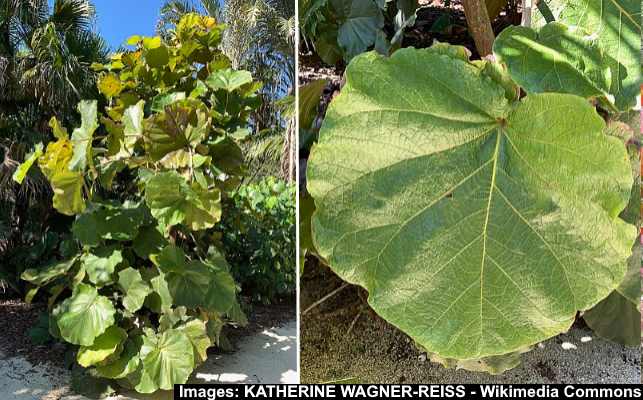
Grandleaf seagrape (Coccoloba pubescens)
Grandleaf seagrape is a medium-sized tree with huge oval or orbicular leaves. The sun-loving, salt-tolerant tree grows up to 78 ft. (24 m) tall. It features a sparse crown, and its leaves measure up to 17” (45 cm) in diameter. However, leaves can grow as large as 35” (90 cm) in diameter.
The upper side of the leaves is bright green, while the underside is paler with yellow to reddish veins. The margin of the leaves is smooth and wavy. The tree produces insignificant greenish-white flowers on upright spikes reaching up to 23” (60 cm) long. The grapes are 0.78” (2 cm) in diameter.
Pigeon seagrape (Coccoloba diversifolia)
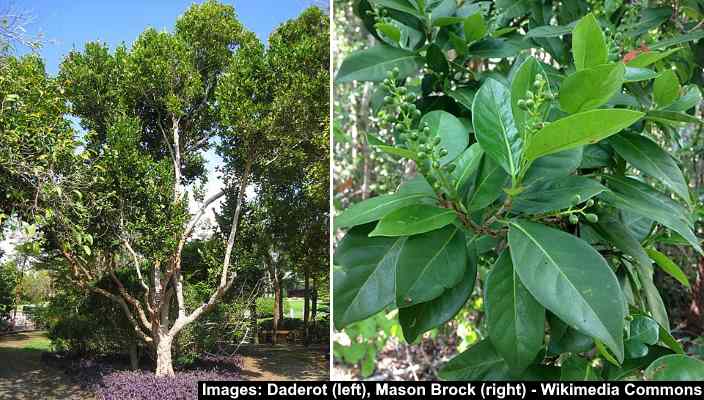
Pigeon seagrape (Coccoloba diversifolia)
Pigeon seagrape is a small to medium-sized tree growing 32 ft. (10 m) tall. Identifying features of the tropical tree are its oval to oblong leaves 1.18” to 5.1” (3 to 13 cm) long and dark purple fleshy grapes. Like other species of seagrape, pigeon seagrape is tolerant to salt, drought, and high winds.
Red-flowered seagrape (Coccoloba rugosa)
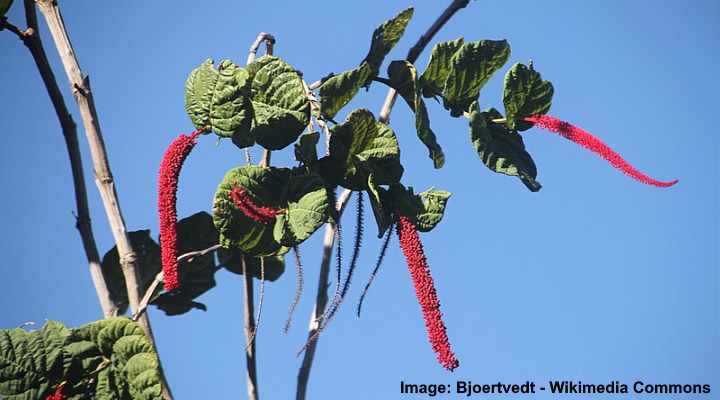
Red-flowered seagrape is a rare tropical plant, identified by its vibrant red racemes. The other outstanding feature of the shrub-like tree is its thick, leathery obovate leaves 23” (60 cm) long. The small red flowers grow in flowering spikes 12” to 18” (30 – 45 cm) long.
Landscaping Uses for Seagrape Trees and Shrubs
Seagrape plants are ideal landscaping solutions if you live near the coast in tropical climates. The trees and shrubs thrive in warm, humid temperatures and perform well in sandy soils. They also withstand Florida’s harsh climate—constant sunshine, hurricanes, and periods of drought.
Here are a few ways seagrape shrubs and trees can enliven your subtropical or tropical garden landscape:
Hedge
Create a vibrant coastal evergreen hedge in Florida using seagrape shrubs. Plant the shrubs 3 to 6 ft. (0.9 – 1.8 m) apart in well-draining soil. Regular pruning maintains a dense and uniform appearance. It also controls their height to your desired size to protect a backyard.
The salt-tolerant nature of seagrape plants makes them an excellent choice for a resilient and aesthetically pleasing hedge along coastal landscapes.
Small specimen tree
Seagrape plants make ideal specimen trees thanks to their stunning foliage and clusters of grapes. You can grow the plant in a sunny location and train it to grow like a tree by pruning lower branches. This helps to develop a single central trunk. Its ornamental value and large, glossy leaves will add aesthetic appeal to your front yard.
Privacy screen or windbreak
Seagrape’s dense evergreen foliage and strong branching system make the shrub ideal as a privacy screen or windbreak. Plant shrubs in a row spaced up to 6 ft. (1.8 m) apart to create a natural barrier. Regularly prune the branches to maintain dense growth and height of the privacy hedge.
This way, you can protect your backyard from strong coastal winds, prying eyes, and unwanted intruders.
Shade plant
You can create shade in your backyard by strategically planting seagrape trees. The trees can grow up to 25 ft. (7.6 m) tall, sometimes even taller. You can create shaded areas requiring relief from intense sunlight. Seagrape’s broad, leathery leaves provide ample shade for patios, decks, or pools in tropical locations.
Related articles:
